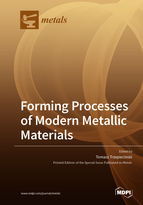Forming Processes of Modern Metallic Materials
A special issue of Metals (ISSN 2075-4701). This special issue belongs to the section "Metal Casting, Forming and Heat Treatment".
Deadline for manuscript submissions: closed (1 May 2020) | Viewed by 72663
Special Issue Editor
Interests: anisotropic plasticity; computational modeling; constitutive modeling; finite element method (FEM); friction; friction welding; manufacturing processes; sheet metal forming; tribology
Special Issues, Collections and Topics in MDPI journals
Special Issue Information
Dear Colleagues,
I would like to call to your attention the Special Issue of Metals on the "Forming Processes of Modern Metallic Materials". The plastic forming of metallic materials is the most efficient and an important manufacturing technology in today's industry. Lightweight materials, such as titanium alloys, aluminium alloys and ultra-high-strength steels are used extensively in the automotive, aerospace, transportation, and construction industries leading to increasing demand for advanced innovative forming technologies. Today, numerical simulation is highly focused and provides a better understanding of the innovative forming processes. Computational methods and numerical analysis coupled with the modelling of the structural evolution allow us to reduce time and eliminate experimental tests.
The aim of this Special Issue is to present the latest achievements in various modern metal forming processes and the latest research related to the computational methods for metal forming technologies. Research articles focusing on new developments in the forming of metallic materials are welcome for consideration of publication. I truly believe that this Special Issue will help the metals research community to enhance understanding of the present status and trends of the forming processes of modern metallic materials. Topics of interest include, but are not limited to:
- aerospace and automotive metal forming technologies,
- computational techniques for metal forming processes,
- high-speed forming technologies,
- technology of incremental sheet forming,
- formability of metallic materials,
- hydroforming processes,
- friction and lubrication in metal forming,
- material behavior modeling of metal forming processes.
Prof. Tomasz Trzepiecinski
Guest Editor
Manuscript Submission Information
Manuscripts should be submitted online at www.mdpi.com by registering and logging in to this website. Once you are registered, click here to go to the submission form. Manuscripts can be submitted until the deadline. All submissions that pass pre-check are peer-reviewed. Accepted papers will be published continuously in the journal (as soon as accepted) and will be listed together on the special issue website. Research articles, review articles as well as short communications are invited. For planned papers, a title and short abstract (about 100 words) can be sent to the Editorial Office for announcement on this website.
Submitted manuscripts should not have been published previously, nor be under consideration for publication elsewhere (except conference proceedings papers). All manuscripts are thoroughly refereed through a single-blind peer-review process. A guide for authors and other relevant information for submission of manuscripts is available on the Instructions for Authors page. Metals is an international peer-reviewed open access monthly journal published by MDPI.
Please visit the Instructions for Authors page before submitting a manuscript. The Article Processing Charge (APC) for publication in this open access journal is 2600 CHF (Swiss Francs). Submitted papers should be well formatted and use good English. Authors may use MDPI's English editing service prior to publication or during author revisions.
Keywords
- Computational methods
- Constitutive modeling
- Finite element method
- Formability
- Friction
- Metal forming
- Metals
- Microstructure
- Sheet metal forming






